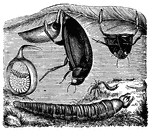
Hydrophilus Piceus
"It is common in fresh waters. It must not be seized without taking precautions, as its breast is provided…

Bristles at the Extremity of the Abdomen of the Hydrophilus Piceus
"The female is sometimes seen clinging to aquatic plants head downward, forming her cocoon, terminated…
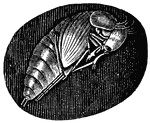
Pupa of the Hydrophilus Piceus
"At the end of two months the larva comes out of the water and burrows into the ground to undergo its…

Dyticus Marginalis (Male)
"The most common species of the Dytici, or Water Beetles. They sometimes attack the Hydrophilus…

Dyticus Marginalis (Female)
"The most common species of the Dytici, or Water Beetles. They sometimes attack the Hydrophilus…
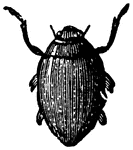
Gyrinus Natator
"They swim rapidly, describing incessantly capricious circles. These movements have gained for them…

Larva of Gyrinus Natator
"They swim rapidly, describing incessantly capricious circles. These movements have gained for them…
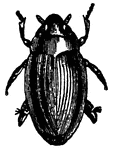
Gyrinus Striatus
"The Gyrinus Striatus is found in the waters of Southern Europe. These insects are all small,…

Gyrinus Distinctus
"A distinct species, which exists in a little lake of mineral waters in France, where visitors amuse…

Golden Ground Beetle (Carabus Auratus)
"Abounds in trees and gardens. When it is touched it disgorges a black and acrid saliva, and ejects…

Carabus Canaliculatus
"Abounds in trees and gardens. When it is touched it disgorges a black and acrid saliva, and ejects…

Pupa of Calosoma Auropunctata
"A very beautiful specimen of this tribe may be found in June on oak-tees."
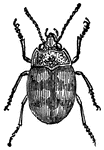
Omophron Libatum
"They are small almost globular, of a pale yellow with green lines, an live in sand bordering rivers."

Nebria Arenaria
"They are small almost globular, of a pale yellow with green lines, an live in sand bordering rivers.…

Campylocnemis Schroeteri
"An Australian insect, of a bright black, which attains to more than an inch and three quarters in length,…

Harpalus Aeneus
"The innumerable tribe of Harpalidae (or Harpalinae) contains carnivorous beetles of very small size.…

Larva of Galerita Lecontei
"The innumerable tribe of Harpalidae (or Harpalinae) contains carnivorous beetles of very small size.…

Larva of Mormolyce Phyllodes
"The innumerable tribe of Harpalidae (or Harpalinae) contains carnivorous beetles of very small size.…

Tiger Beetle (Cicindela Heros)
"Their ferocity is remarkable. They quickly tear off the wings and legs of their victim, and suck out…
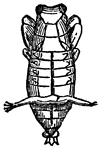
Upper Side of Pupa of Tiger Beetle (Cicindela Heros)
"Their ferocity is remarkable. They quickly tear off the wings and legs of their victim, and suck out…

Under Side of Pupa of Tiger Beetle (Cicindela Heros)
"Their ferocity is remarkable. They quickly tear off the wings and legs of their victim, and suck out…

Ctenostoma Rugosa
"According to a traveler, the women of Egypt eat these cooked with butter to make them fat. They are…
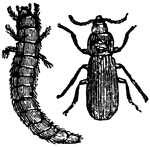
Tenebrio Molitor (Larva and Imago)
"A blackish-brown insect. The larvae are the well-known meal-worms, which live in flour."
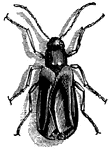
Sitaris Humeralis
"The female Sitaris Humeralis lays at the entrance of the nest of a solitary bee from 2,000…

First Larva of Sitaris Humeralis
"A month afterward there come out of these eggs very small larvae, of a shining dark green, hard-skinned,…

Pseudo Nymph of Sitaris Humeralis
"When the male bees have built the cells and furnished them with honey, the female, as we know, deposits…

Third Larva of Sitaris Humeralis
The second larva stage lasts for 6 weeks. It contracts and passes through the winter. "In the spring…

Pupa of Sitaris Humeralis
The second larva stage lasts for 6 weeks. It contracts and passes through the winter. "In the spring…

Male Lampyris Noctiluca
"It has the power of making its natural torch shine or disappear at will. The luminous properties with…

Female Lampyris Noctiluca
"It has the power of making its natural torch shine or disappear at will. The luminous properties with…
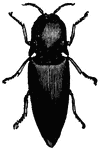
Cucuyo (Pyrophorus Noctilucus)
"An insect very common in Havana, Brazil, Guiana and Mexico. It may be seen at night in great numbers…
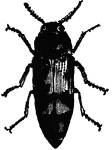
Buprestis (Cyria) Imperialis
"It is very rare in northern climates. It may be found on birch trees. In the hottest parts of the world…

Hylesinus Piniperda
"All vegetables, the vine, fruit trees, the ash, pine, etc., are eaten by some weevil or other."
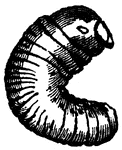
Larva of Scolytus
"Sometimes this larva destroys great forests of oak trees. In 1783, in the Forest of Hartz, 1,500,000…

Stick Insect
The Phasmatodea (sometimes called Plasmodia) are an order of insects, whose members are variously known…
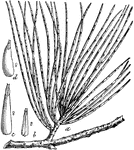
Pine Needle Scale
"a, Scales of Chionaspis pinifoliae upon pine-leaves, natural size; b, scale of male, enlarged; c, straight…
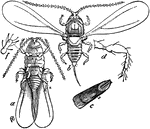
Scale Insect
"Scale-insect. Oyster-shell bark-louse of the apple (Mytilaspis pomorum); male. a, ventral view with…

Carrion Beetle
"Carrion-beetle (Silpha inaequalis). a, larva; d, same; f, g, h, mandible, labium, and maxilla of larva;…

Assassin Bug
Ectrichodia cruciata is a species of assassin bugs in the Hemiptera order of true bugs.
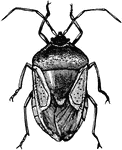
Stink Bug
Edessa bifida is a species of stink bug in the Pentatomidae family of stink and shield bugs.
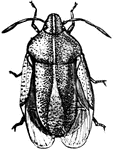
Stink Bug
Eurygaster alternatus is an insect species in the Pentatomidae family of stink bugs and shield bugs.
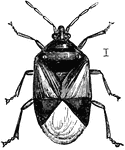
Insidious Flower Bug
The Insidious Flower Bug is an insect in the Heteroptera suborder of true bugs.
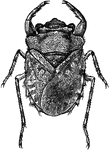
Dorsal View of Toad Bug
Galgulus oculatus is a true bug species in the Gelastocoridae family of toad bugs.
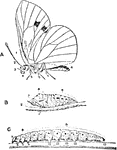
Three Stages of Cabbage Buterfly
A sequenced illustration of the cabbage butterfly undergoing metamorphosis. The butterfly starts out…

Potato Beetle
Also known as Doryphora decemlineata. It is approximately 10 millimeters in length, with a bright yellow…
!["The [potato beetle larva] is pale yellow, or, rather, dusky-yellow, or freckled with minute black dots on the back; and there are two rows of larger black dots along each side; the legs are black."—Nicholson, 1884](https://etc.usf.edu/clipart/79000/79099/79099_potatolarva_mth.gif)
Larva of Potato Beetle
"The [potato beetle larva] is pale yellow, or, rather, dusky-yellow, or freckled with minute black dots…

Larva, Frothy Section, and Perfect Insect of the Frog Hopper
Frog hoppers belong to the order Heteroptera. This order is also known as plant bugs. These insects…

Male and Female Cockchafer
Cockchafer, also known as may bugs, is the common name of melolontha vulgaris. These beetles are native…
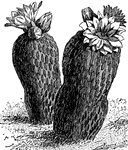
Pelecyphora Aselliformis
Illustrated is the extreme condensation of the plant body of pelecyphora aselliformis. The spines resemble…
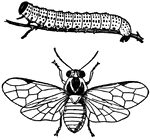
Gooseberry Caterpillar (Nematus ribesii) and Sawfly
Gooseberry Caterpillar is the name applied to the larvæ of two different insects, both injurious to…

Phytocoris
A genus of plant bugs, having the beak extending to the middle of the abdomen and the sides of the head…





